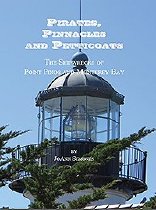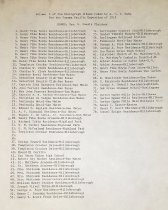Person Record
Metadata
Name |
Parrott, John |
Notes |
Another of our distinguished early citizens was John Parrott. Like only a few others, he arrived in California already rich and successful. He had traded in hides and tallow in Mexico long before the gold rush. He had been named US Consul at Mazatlan in 1838. This honorary position brought prestige, but it did not include any pay. While Parrott was given the respect that his wealth and position commanded, he was not without his flaws. It was known that he had fathered at least two children by different Mexican women. Some of his business dealings in those early days would have been called smuggling today. Nevertheless, when he arrived in San Francisco, Parrott was already established as a respectable and influential man. He became a banker and accumulated real estate in San Francisco and elsewhere. He invested in many different successful business ventures. He had originally been from The South, and he became a typical southern conservative businessman. Unlike some other San Franciscans of the time, Parrott never revealed the extent of his wealth, so it was rumored that he was richer than many of the others. While on a business trip to Alabama, Parrott met the sister of one of his associates. She was 18 years younger than he, but John was immediately attracted to her. She happened to be a school chum of his daughter Magdalena. They were married in the Catholic Church in 1853, and Parrott brought her back to California. John Parrott built the requisite mansion in the City, and in 1859 he bought an estate in San Mateo from Frederick Macondray. It bordered today's El Camino Real into the hills to the west. Parrott called the place Baywood. He indulged his fancy for thoroughbred horses, and imported cattle and other animals for his 377-acre country home. After nine years, he replaced the modest single story house with a larger home in keeping with his position. Of course this was only a summer place, but it had hydraulic elevators and was designed along French Second Empire lines. Nevertheless, they were not known as party givers. Family and church were their main interests. John and Abby Parrott had eight children. There were six girls and two boys, but one of the boys died in infancy. John did not neglect his responsibility for his Mexican born son and daughter, either. They were brought here and educated at boarding schools appropriate to their father's wealth. In fact, his son, Tiburcio, took over the Parrott Bank when John retired. The Parrotts were naturally concerned with seeing to it that their many daughters married well. In this, too, they were successful. Two married into French nobility and one wed an English nobleman. Two others made good American alliances; one married a local judge and another a West Point trained army officer. Their son and remaining daughter both married into another local banking family, solidifying a business alliance. Even Parrott's illegitimate daughter married a wealthy English physician. Parrott died in 1884. Their San Francisco home was destroyed in the earthquake and fire of 1906, and after that Abby Parrott made San Mateo her home. Abby had promised John never to turn away a hungry man, so she regularly fed 50 to 100 at her back door. A special campground was set up for this purpose. By her death in 1917, it was estimated she had fed 300,000 destitute people. (Joan Levy/2006) See also "San Mateo's John Parrot family" San Mateo Daily Journal, March 16, 2009 by Darold Fredricks |
Born |
1810 |
Birthplace |
Virginia |
Deceased |
1884 |
Occupation |
Merchant, Trader, Banker, Capitalist |
Titles & honors |
US Consul to Mazatlan |
Places of residence |
Virginia Mexico San Francisco San Mateo |
Spouse |
Abigail "Abby" Meagher |
Children |
Magdalena Tiburcio Mary Katherine de Guigne Abby Josephine Payson Grace Almaden Hayne John, Jr. (m. Mary E. Donohoe) Noelie Christine Regina May Edith Isabelle |
Related Records
-
Documents related to research on Point Pinos Lighthouse, 1849-2013 - Archive
The documents within this collection were complied and used to conduct research on Point Pinos Lighthouse by JoAnn Semones for her book, Pirates, Pinnacles and Petticoats. Items in collection include: Notes, newspaper clippings, website articles, email correspondence, pages from journal, biography, story, book review, references, obituaries, shipwreck database information, and other information regarding the shipwrecks, and the people associated ...
Record Type: Archive

-
John Parrott Portrait by P. Baumgras, 1873 - Portrait
John Parrott Portrait by P. Baumgras, 1873. Oil on canvas is mounted inside a deep ornate gold painted wood and gesso frame with large flowers decorating the outer corners and a geometric motif decorating the inner corners. On front bottom center of frame is a gold-colored paper label with vinyl lettering that reads, "John P rrot" [the 'a' is missing]. Image depicts Parrot standing in front of a fireplace and leaning against a chair back with ...
Record Type: Object

-
Pirates, Pinnacles, and Petticoats: The Shipwrecks of Point Pinos and Monterey Bay - Semones, JoAnn
Pirates, Pinnacles, and Petticoats: The Shipwrecks of Point Pinos and Monterey Bay by JoAnn Semones, 2015. Front cover is a close-up photograph of part of the lighthouse of Point Pinos in Monterey Bay from JoAnn Semones. Includes stories and histories of shipwrecks along or near Point Pinos Lighthouse. Dimensions: 10.250 x 7.250 x 0.125
Record Type: Library

-
Volume I of the Photograph Albums taken by A. G. C. Hahn for the Panama Pacific Exposition of 1915 - Album, Photograph
One of three photograph albums showing San Mateo County locations. Photographs taken by A. G. C. Hahn for the Panama Pacific Exposition of 1915. Contains images 1-78. Volume I of the Photograph Albums taken by A. G. C. Hahn for the Panama Pacific Exposition of 1915 1. Henry Pike Bowie Residence-Hillsborough 2. Henry Pike Bowie Residence-Hillsborough 3. Henry Pike Bowie Residence-Hillsborough 4. Henry Pike Bowie Residence-Hillsborough ...
Record Type: Photo

